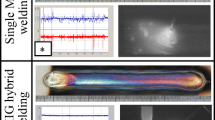Abstract
Tungsten inert gas (TIG) and metal inert gas (MIG) welding are the most popular gas-shielded arc-welding processes used in many industrial fields. MIG welding is a high-efficiency process compared to TIG welding. However, improvements are needed to reduce spatter and improve weld metal toughness. Although pure argon shielding gas is desirable for weld metal toughness, MIG arcs are unstable in pure Ar to the extent that executing welding is difficult. We have found that MIG arcs become stable even using pure argon by simply using a hybrid TIG and MIG system. This process has the possibility of becoming a new welding process giving high quality and efficiency. In this study, we investigate the influence of the balance of current between the TIG and MIG arcs, which is most important in determining arc stability and arc penetration. We have confirmed the suitable range of conditions both experimentally and through numerical simulation and have applied this process for butt and fillet joints. We show that the welding time can be reduced to 17 ~ 44 % of the time required using a conventional TIG process.










Similar content being viewed by others
References
Kamiya H, Fujita T, Enjo Y (1985) Kikkuchi: oxygen content and fracture toughness on MIG weld metal of SUS 304 steel. Quart J Japan Weld Soc 3(3):138–145 (in Japanese)
Matsuda F, Ushio M, Saikawa S, Maruyama Y, Araya T (1983) Study on GMA welding for 9 % Ni steel with similarly composed nickel alloy wire. Journal of Japan Welding Society 82(3):66–73, in Japanese
Zenitani S, Nakamura T, Hiraoka K, Shinozaki K (2007) Ar–MIG arc behavior in local addition of small amount of oxygen into shielding gas. Quart J Japan Weld Soc 25(1):187–195 (in Japanese)
Kanemaru S, Sasaki T, Sato T, Tanaka M (2012) Basic study of TIG-MIG hybrid welding process. Quart J Japan Weld Soc 30(1):29–34 (in Japanese)
Qin GL, Lei Z, Lin SY (2007) Effect of Nd:YAG laser + pulsed MAG arc hybrid welding parameters on its weld shape. Sci Technol Weld Joi 12(1):79–86
Ueyama T, Ohnawa T, Tanaka M, Nakata K (2005) Effects of torch configuration and welding current on weld bead formation in high-speed tandem pulsed gas metal arc welding of steel sheets. Science and Technology of Welding & Joining 10(6):750–759
Kobayashi K, Matusoka T, Ushio M, Tanaka M (2003) The elucidation of twin-electrodes TIG arc phenomenon. Preprints of The National Meeting of Japan Welding Society 73:194–195 (in Japanese)
Li KH, Zhang YM (2007) Metal transfer in double-electrode gas metal arc welding. J Manuf Sci E-T ASME 129(6):991–999
Li KH, Chen JS, Zhang YM (2007) Double-electrode GMAW process and control. Weld J 86(8):231s–237s
Li KH, Zhang YM (2008) Consumable double-electrode GMAW part I: the process. Weld J 87(1):11s–17s
Li KH, Zhang YM (2008) Consumable double-electrode GMAW part II: monitoring, modeling, and control. Weld J 87(2):44s–50s
Li KH, Zhang YM, XU P, Yang FQ (2008) High-strength steel welding with consumable double-electrode gas metal arc welding. Weld J 87(3):57s–64s
Shi Y, Liu X, Zhang Y, Johnson M (2008) Analysis of metal transfer and correlated influences in dual-bypass GMAW of aluminum. Weld J 87(9):229s–236s
Li K, Wu C (2009) Mechanism of metal transfer in DE-GMAW. J Mater Sci Technol 25(3):415–418
Chen JS, Lu Y, Li XR, Zhang YM (2012) Gas tungsten arc welding using an arcing wire. Weld J 91(5):216s–269s
Kanemaru S, Sasaki T, Sato T, Mishima H, Tashiro S, Tanaka M (2012) Study for the arc phenomena of TIG–MIG hybrid welding process by 3D numerical analysis model. Quart J Japan Weld Soc 30(4):323–330 (in Japanese)
Author information
Authors and Affiliations
Corresponding author
Additional information
Doc. IIW-2406, recommended for publication by Commission XII “Arc Welding Processes and Production Systems.
Rights and permissions
About this article
Cite this article
Kanemaru, S., Sasaki, T., Sato, T. et al. Study for TIG–MIG hybrid welding process. Weld World 58, 11–18 (2014). https://doi.org/10.1007/s40194-013-0090-y
Received:
Accepted:
Published:
Issue Date:
DOI: https://doi.org/10.1007/s40194-013-0090-y




